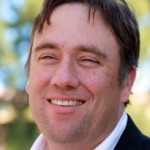Opinion: No city immune from an identity crisis
By Joe Mathews
Can you imagine Southern California without Hollywood? Or the Bay Area without Silicon Valley?
No? History suggests that the identities of cities and regions are more fragile, and their central industries more perilous, than we care to admit. (Just ask Detroit autoworkers.)

Joe Mathews
So it’s quite possible that Los Angeles’ entertainment industry–struggling with shifting business models and technology that allow film production just about anywhere—could be much smaller in the near future. And Silicon Valley? Here’s a nightmare scenario: What if the security state escalates its current war against Apple to the point that technology companies relocate headquarters to countries with laws that protect customers’ privacy? Heck, they may be able to lower their taxes while they’re at it.
These dark thoughts occurred to me while reading a smart new book about a different California place—Bakersfield—and its identity as a capital of country music.
“The Bakersfield Sound: How a Generation of Displaced Okies Revolutionized American Music”, by Bakersfield Californian editor Robert E. Price is an entertaining history, essential for fans of country and its greatest San Joaquin Valley musicians, Merle Haggard and the late Buck Owens. But the book also says something profound—and troubling—about how places come to be hotbeds of a particular enterprise, and how they can lose that identity.
Bakersfield became a country music capital through accident and intention. The accident was the Dust Bowl, which brought environmental refugees to Kern County in the 1930s and ’40s. The migrants were outsiders among Bakersfield’s elites, so they mixed with each other and other outsiders—creating music in the post-World War II years that was informed by what Price calls “a synergy of economic hardship, determination, kinship, and dumb luck.”
Location helped; Bakersfield is close enough to Los Angeles to benefit from its energy and musicians, but far enough away not to be infected by its glossiness. And technology played a role, too, with the invention of Clarence “Leo” Fender’s Telecaster, the guitar that produced the rough, uncultivated country that became known as the Bakersfield Sound.
The intention involved the creation of infrastructure to support a community and of musicians. In Bakersfield, that infrastructure consisted of the honky tonks, starting most crucially with Joe Limi and Frank Zabaleta’s north side place, the Blackboard, and growing to more than 20 clubs with live music by the 1960s. Bakersfield’s musicians had audiences and gigs to pay the bills.
But here’s where the story of the Bakersfield Sound becomes its own sad country song. Bakersfield has lost its status as a capital of country. Why? Cultural infrastructure didn’t develop as deeply in Bakersfield as in other places—like Nashville—where “saloons (or art galleries) beget restaurants, which beget jobs, which beget hotels, which beget apartments and markets and home improvement stores.”
Social change undermined the Bakersfield Sound, the longtime music engineer Jim Shaw has noted—particularly the rise of Mothers Against Drunk Driving, which made a night of drinking and driving between honky tonks a dicier proposition.
Another problem, paradoxically, was the success, and expansion, of the Bakersfield Sound, as other musicians borrowed it and made it their own. Price shows how “the Bakersfield Sound never really died… [A] big chunk of it up and moved to Texas,” where you can still hear it on Austin’s Sixth Street. And KWMR, a radio station in Marin County, of all places, keeps the sound alive with its program, “Bakersfield and Beyond.”
Bakersfield still has a music scene, but it’s harder to find. Buck Owens’ Crystal Palace remains a vital venue for country; Trout’s Nightclub is still around. I’m a big fan of Jerry’s Pizza and Pub downtown, where owner Jerry Baranowski, a sharp-talking Polish immigrant, says he hosts two kinds of musicians: the very good and the very local.
Price identifies two lessons for communities: First, cities must develop strong identities. And second, they can never allow that development to stop, even after they’ve created a culture so central to their identities that it wouldn’t seem to need nurturing.
“Every American city, whether it prides itself on its public sculptures or deep-dish pizza, on hot-air balloons or woolen jackets, on abundant trout streams or Greek architecture, needs to develop that identity, or if it has been allowed to escape, remember what it once was,” Price writes, adding: “It’s a conversation Bakersfield should have initiated decades ago.”
It’s an especially important conversation in California—because we are so defined by industries that rely on ideas, stories, and art that can leave our state in the blink of an eye. The promise of our creative industries is also its peril. These days, you can write code, make movies, or hear the Bakersfield Sound just about anywhere.
Joe Mathews writes the Connecting California column for Zócalo Public Square.



People from 147 countries read this ‘paper’.
They come here with their entire families and entirely alone. They appreciate ‘Big Blue’ for experiences that suit the family as a group and that offer activities for individuals also.
Lake Tahoe is not a retirement community for the 80yrs+ population that has health issues and limitations.